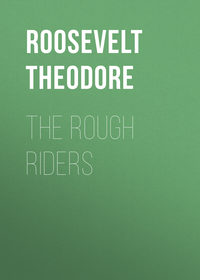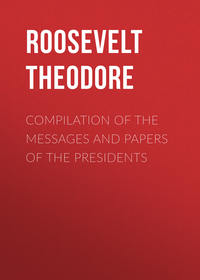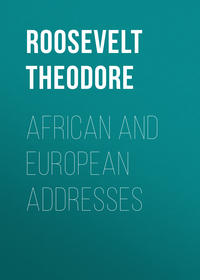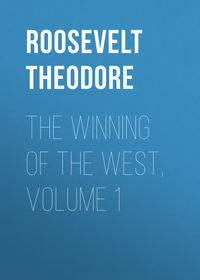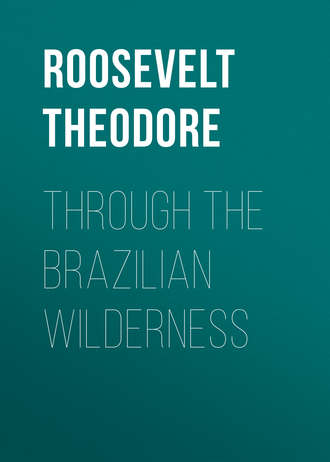 полная версия
полная версияThrough the Brazilian Wilderness
The birds were tame, even those striking and beautiful birds which under man's persecution are so apt to become scarce and shy. The huge jabiru storks, stalking through the water with stately dignity, sometimes refused to fly until we were only a hundred yards off; one of them flew over our heads at a distance of thirty or forty yards. The screamers, crying curu-curu, and the ibises, wailing dolefully, came even closer. The wonderful hyacinth macaws, in twos and threes, accompanied us at times for several hundred yards, hovering over our heads and uttering their rasping screams. In one wood we came on the black howler monkey. The place smelt almost like a menagerie. Not watching with sufficient care I brushed against a sapling on which the venomous fire-ants swarmed. They burnt the skin like red-hot cinders, and left little sores. More than once in the drier parts of the marsh we met small caymans making their way from one pool to another. My horse stepped over one before I saw it. The dead carcasses of others showed that on their wanderings they had encountered jaguars or human foes.
We had been out about three hours when one of the dogs gave tongue in a large belt of woodland and jungle to the left of our line of march through the marsh. The other dogs ran to the sound, and after a while the long barking told that the thing, whatever it was, was at bay or else in some refuge. We made our way toward the place on foot. The dogs were baying excitedly at the mouth of a huge hollow log, and very short examination showed us that there were two peccaries within, doubtless a boar and sow. However, just at this moment the peccaries bolted from an unsuspected opening at the other end of the log, dove into the tangle, and instantly disappeared with the hounds in full cry after them. It was twenty minutes later before we again heard the pack baying. With much difficulty, and by the incessant swinging of the machetes, we opened a trail through the network of vines and branches. This time there was only one peccary, the boar. He was at bay in a half-hollow stump. The dogs were about his head, raving with excitement, and it was not possible to use the rifle; so I borrowed the spear of Dom Joao the younger, and killed the fierce little boar therewith.
This was an animal akin to our collared peccary, smaller and less fierce than its white-jawed kinsfolk. It is a valiant and truculent little beast, nevertheless, and if given the chance will bite a piece the size of a teacup out of either man or dog. It is found singly or in small parties, feeds on roots, fruits, grass, and delights to make its home in hollow logs. If taken young it makes an affectionate and entertaining pet. When the two were in the hollow log we heard them utter a kind of moaning, or menacing, grunt, long drawn.
An hour or two afterward we unexpectedly struck the fresh tracks of two jaguars and at once loosed the dogs, who tore off yelling, on the line of the scent. Unfortunately, just at this moment the clouds burst and a deluge of rain drove in our faces. So heavy was the downpour that the dogs lost the trail and we lost the dogs. We found them again only owing to one of our caboclos; an Indian with a queer Mongolian face, and no brain at all that I could discover, apart from his special dealings with wild creatures, cattle, and horses. He rode in a huddle of rags; but nothing escaped his eyes, and he rode anything anywhere. The downpour continued so heavily that we knew the rodeo had been abandoned, and we turned our faces for the long, dripping, splashing ride homeward. Through the gusts of driving rain we could hardly see the way. Once the rain lightened, and half a mile away the sunshine gleamed through a rift in the leaden cloud-mass. Suddenly in this rift of shimmering brightness there appeared a flock of beautiful white egrets. With strong, graceful wing-beats the birds urged their flight, their plumage flashing in the sun. They then crossed the rift and were swallowed in the gray gloom of the day.
On the marsh the dogs several times roused capybaras. Where there were no ponds of sufficient size the capybaras sought refuge in flight through the tangled marsh. They ran well. Kermit and Fiala went after one on foot, full-speed, for a mile and a half, with two hounds which then bayed it—literally bayed it, for the capybara fought with the courage of a gigantic woodchuck. If the pack overtook a capybara, they of course speedily finished it; but a single dog of our not very valorous outfit was not able to overmatch its shrill-squeaking opponent.
Near the ranch-house, about forty feet up in a big tree, was a jabiru's nest containing young jabirus. The young birds exercised themselves by walking solemnly round the edge of the nest and opening and shutting their wings. Their heads and necks were down-covered, instead of being naked like those of their parents. Fiala wished to take a moving-picture of them while thus engaged, and so, after arranging his machine, he asked Harper to rouse the young birds by throwing a stick up to the nest. He did so, whereupon one young jabiru hastily opened its wings in the desired fashion, at the same time seizing the stick in its bill! It dropped it at once, with an air of comic disappointment, when it found that the stick was not edible.
There were many strange birds round about. Toucans were not uncommon. I have never seen any other bird take such grotesque and comic attitudes as the toucan. This day I saw one standing in the top of a tree with the big bill pointing straight into the air and the tail also cocked perpendicularly. The toucan is a born comedian. On the river and in the ponds we saw the finfoot, a bird with feet like a grebe and bill and tail like those of a darter, but, like so many South American birds, with no close affiliations among other species. The exceedingly rich bird fauna of South America contains many species which seem to be survivals from a very remote geologic past, whose kinsfolk have perished under the changed conditions of recent ages; and in the case of many, like the hoatzin and screamer, their like is not known elsewhere. Herons of many species swarmed in this neighborhood. The handsomest was the richly colored tiger bittern. Two other species were so unlike ordinary herons that I did not recognize them as herons at all until Cherrie told me what they were. One had a dark body, a white-speckled or ocellated neck, and a bill almost like that of an ibis. The other looked white, but was really mauve-colored, with black on the head. When perched on a tree it stood like an ibis; and instead of the measured wing-beats characteristic of a heron's flight, it flew with a quick, vigorous flapping of the wings. There were queer mammals, too, as well as birds. In the fields Miller trapped mice of a kind entirely new.
Next morning the sky was leaden, and a drenching rain fell as we began our descent of the river. The rainy season had fairly begun. For our good fortune we were still where we had the cabins aboard the boat, and the ranch-house, in which to dry our clothes and soggy shoes; but in the intensely humid atmosphere, hot and steaming, they stayed wet a long time, and were still moist when we put them on again. Before we left the house where we had been treated with such courteous hospitality—the finest ranch-house in Matto Grosso, on a huge ranch where there are some sixty thousand head of horned cattle—the son of our host, Dom Joao the younger, the jaguar-hunter, presented me with two magnificent volumes on the palms of Brazil, the work of Doctor Barboso Rodriguez, one-time director of the Botanical Gardens at Rio Janeiro. The two folios were in a box of native cedar. No gift more appropriate, none that I would in the future value more as a reminder of my stay in Matto Grosso, could have been given me.
All that afternoon the rain continued. It was still pouring in torrents when we left the Cuyaba for the Sao Lourenco and steamed up the latter a few miles before anchoring; Dom Joao the younger had accompanied us in his launch. The little river steamer was of very open build, as is necessary in such a hot climate; and to keep things dry necessitated also keeping the atmosphere stifling. The German taxidermist who was with Colonel Rondon's party, Reinisch, a very good fellow from Vienna, sat on a stool, alternately drenched with rain and sweltering with heat, and muttered to himself: "Ach, Schweinerei!"
Two small caymans, of the common species, with prominent eyes, were at the bank where we moored, and betrayed an astonishing and stupid tameness. Neither the size of the boat nor the commotion caused by the paddles in any way affected them. They lay inshore, not twenty feet from us, half out of water; they paid not the slightest heed to our presence, and only reluctantly left when repeatedly poked at, and after having been repeatedly hit with clods of mud and sticks; and even then one first crawled up on shore, to find out if thereby he could not rid himself of the annoyance we caused him.
Next morning it was still raining, but we set off on a hunt, anyway, going afoot. A couple of brown camaradas led the way, and Colonel Rondon, Dom Joao, Kermit, and I followed. The incessant downpour speedily wet us to the skin. We made our way slowly through the forest, the machetes playing right and left, up and down, at every step, for the trees were tangled in a network of vines and creepers. Some of the vines were as thick as a man's leg. Mosquitoes hummed about us, the venomous fire-ants stung us, the sharp spines of a small palm tore our hands—afterward some of the wounds festered. Hour after hour we thus walked on through the Brazilian forest. We saw monkeys, the common yellowish kind, a species of cebus; a couple were shot for the museum and the others raced off among the upper branches of the trees. Then we came on a party of coatis, which look like reddish, long-snouted, long-tailed, lanky raccoons. They were in the top of a big tree. One, when shot at and missed, bounced down to the ground, and ran off through the bushes; Kermit ran after it and secured it. He came back, to find us peering hopelessly up into the tree top, trying to place where the other coatis were. Kermit solved the difficulty by going up along some huge twisted lianas for forty or fifty feet and exploring the upper branches; whereupon down came three other coatis through the branches, one being caught by the dogs and the other two escaping. Coatis fight savagely with both teeth and claws. Miller told us that he once saw one of them kill a dog. They feed on all small mammals, birds, and reptiles, and even on some large ones; they kill iguanas; Cherrie saw a rattling chase through the trees, a coati following an iguana at full speed. We heard the rush of a couple of tapirs, as they broke away in the jungle in front of the dogs and headed, according to their custom, for the river; but we never saw them. One of the party shot a bush deer—a very pretty, graceful creature, smaller than our whitetail deer, but kin to it and doubtless the southernmost representative of the whitetail group.
The whitetail deer—using the word to designate a group of deer which can neither be called a subgenus with many species, nor a widely spread species diverging into many varieties—is the only North American species which has spread down into and has outlying representatives in South America. It has been contended that the species has spread from South America northward. I do not think so; and the specimen thus obtained furnished a probable refutation of the theory. It was a buck, and had just shed its small antlers. The antlers are, therefore, shed at the same time as in the north, and it appears that they are grown at the same time as in the north. Yet this variety now dwells in the tropics south of the equator, where the spring, and the breeding season for most birds, comes at the time of the northern fall in September, October, and November. That the deer is an intrusive immigrant, and that it has not yet been in South America long enough to change its mating season in accordance with the climate, as the birds—geologically doubtless very old residents—have changed their breeding season, is rendered probable by the fact that it conforms so exactly in the time of its antler growth to the universal rule which obtains in the great arctogeal realm, where deer of many species abound and where the fossil forms show that they have long existed. The marsh-deer, which has diverged much further from the northern type than this bush deer (its horns show a likeness to those of a blacktail), often keeps its antlers until June or July, although it begins to grow them again in August; however, too much stress must not be laid on this fact, inasmuch as the wapiti and the cow caribou both keep their antlers until spring. The specialization of the marsh- deer, by the way, is further shown in its hoofs, which, thanks to its semi-aquatic mode of life, have grown long, like those of such African swamp antelopes as the lechwe and situtunga.
Miller, when we presented the monkeys to him, told us that the females both of these monkeys and of the howlers themselves took care of the young, the males not assisting them, and moreover that when the young one was a male he had always found the mother keeping by herself, away from the old males. On the other hand, among the marmosets he found the fathers taking as much care of the young as the mothers; if the mother had twins, the father would usually carry one, and sometimes both, around with him.
After we had been out four hours our camaradas got lost; three several times they travelled round in a complete circle; and we had to set them right with the compass. About noon the rain, which had been falling almost without interruption for forty-eight hours, let up, and in an hour or two the sun came out. We went back to the river, and found our rowboat. In it the hounds—a motley and rather worthless lot—and the rest of the party were ferried across to the opposite bank, while Colonel Rondon and I stayed in the boat, on the chance that a tapir might be roused and take to the river. However, no tapir was found; Kermit killed a collared peccary, and I shot a capybara representing a color-phase the naturalists wished.
Next morning, January 1, 1914, we were up at five and had a good New Year's Day breakfast of hardtack, ham, sardines, and coffee before setting out on an all day's hunt on foot. I much feared that the pack was almost or quite worthless for jaguars, but there were two or three of the great spotted cats in the neighborhood and it seemed worth while to make a try for them anyhow. After an hour or two we found the fresh tracks of two, and after them we went. Our party consisted of Colonel Rondon, Lieutenant Rogaciano—an excellent man, himself a native of Matto Grosso, of old Matto Grosso stock—two others of the party from the Sao Joao ranch, Kermit, and myself, together with four dark-skinned camaradas, cowhands from the same ranch. We soon found that the dogs would not by themselves follow the jaguar trail; nor would the camaradas, although they carried spears. Kermit was the one of our party who possessed the requisite speed, endurance, and eyesight, and accordingly he led. Two of the dogs would follow the track half a dozen yards ahead of him, but no farther; and two of the camaradas could just about keep up with him. For an hour we went through thick jungle, where the machetes were constantly at work. Then the trail struck off straight across the marshes, for jaguars swim and wade as freely as marsh-deer. It was a hard walk. The sun was out. We were drenched with sweat. We were torn by the spines of the innumerable clusters of small palms with thorns like needles. We were bitten by the hosts of fire-ants, and by the mosquitoes, which we scarcely noticed where the fire-ants were found, exactly as all dread of the latter vanished when we were menaced by the big red wasps, of which a dozen stings will disable a man, and if he is weak or in bad health will seriously menace his life. In the marsh we were continually wading, now up to our knees, now up to our hips. Twice we came to long bayous so deep that we had to swim them, holding our rifles above water in our right hands. The floating masses of marsh grass, and the slimy stems of the water-plants, doubled our work as we swam, cumbered by our clothing and boots and holding our rifles aloft. One result of the swim, by the way, was that my watch, a veteran of Cuba and Africa, came to an indignant halt. Then on we went, hampered by the weight of our drenched clothes while our soggy boots squelched as we walked. There was no breeze. In the undimmed sky the sun stood almost overhead. The heat beat on us in waves. By noon I could only go forward at a slow walk, and two of the party were worse off than I was. Kermit, with the dogs and two camaradas close behind him, disappeared across the marshes at a trot. At last, when he was out of sight, and it was obviously useless to follow him, the rest of us turned back toward the boat. The two exhausted members of the party gave out, and we left them under a tree. Colonel Rondon and Lieutenant Rogaciano were not much tired; I was somewhat tired, but was perfectly able to go for several hours more if I did not try to go too fast; and we three walked on to the river, reaching it about half past four, after eleven hours' stiff walking with nothing to eat. We were soon on the boat. A relief party went back for the two men under the tree, and soon after it reached them Kermit also turned up with his hounds and his camaradas trailing wearily behind him. He had followed the jaguar trail until the dogs were so tired that even after he had bathed them, and then held their noses in the fresh footprints, they would pay no heed to the scent. A hunter of scientific tastes, a hunter-naturalist, or even an outdoors naturalist, or faunal naturalist interested in big mammals, with a pack of hounds such as those with which Paul Rainey hunted lion and leopard in Africa, or such a pack as the packs of Johnny Goff and Jake Borah with which I hunted cougar, lynx, and bear in the Rockies, or such packs as those of the Mississippi and Louisiana planters with whom I have hunted bear, wild-cat, and deer in the cane-brakes of the lower Mississippi, would not only enjoy fine hunting in these vast marshes of the upper Paraguay, but would also do work of real scientific value as regards all the big cats.
Only a limited number of the naturalists who have worked in the tropics have had any experience with the big beasts whose life- histories possess such peculiar interest. Of all the biologists who have seriously studied the South American fauna on the ground, Bates probably rendered most service; but he hardly seems even to have seen the animals with which the hunter is fairly familiar. His interests, and those of the other biologists of his kind, lay in other directions. In consequence, in treating of the life-histories of the very interesting big game, we have been largely forced to rely either on native report, in which acutely accurate observation is invariably mixed with wild fable, or else on the chance remarks of travellers or mere sportsmen, who had not the training to make them understand even what it was desirable to observe. Nowadays there is a growing proportion of big-game hunters, of sportsmen, who are of the Schilling, Selous, and Shiras type. These men do work of capital value for science. The mere big-game butcher is tending to disappear as a type. On the other hand, the big-game hunter who is a good observer, a good field naturalist, occupies at present a more important position than ever before, and it is now recognized that he can do work which the closest naturalist cannot do. The big-game hunter of this type and the outdoors, faunal naturalist, the student of the life-histories of big mammals, have open to them in South America a wonderful field in which to work.
The fire-ants, of which I have above spoken, are generally found on a species of small tree or sapling, with a greenish trunk. They bend the whole body as they bite, the tail and head being thrust downward. A few seconds after the bite the poison causes considerable pain; later it may make a tiny festering sore. There is certainly the most extraordinary diversity in the traits by which nature achieves the perpetuation of species. Among the warrior and predaceous insects the prowess is in some cases of such type as to render the possessor practically immune from danger. In other cases the condition of its exercise may normally be the sacrifice of the life of the possessor. There are wasps that prey on formidable fighting spiders, which yet instinctively so handle themselves that the prey practically never succeeds in either defending itself or retaliating, being captured and paralyzed with unerring efficiency and with entire security to the wasp. The wasp's safety is absolute. On the other hand, these fighting ants, including the soldiers even among the termites, are frantically eager for a success which generally means their annihilation; the condition of their efficiency is absolute indifference to their own security. Probably the majority of the ants that actually lay hold on a foe suffer death in consequence; certainly they not merely run the risk of but eagerly invite death.
The following day we descended the Sao Lourenco to its junction with the Paraguay, and once more began the ascent of the latter. At one cattle-ranch where we stopped, the troupials, or big black and yellow orioles, had built a large colony of their nests on a dead tree near the primitive little ranch-house. The birds were breeding; the old ones were feeding the young. In this neighborhood the naturalists found many birds that were new to them, including a tiny woodpecker no bigger than a ruby-crowned kinglet. They had collected two night monkeys—nocturnal monkeys, not as agile as the ordinary monkey; these two were found at dawn, having stayed out too late.
The early morning was always lovely on these rivers, and at that hour many birds and beasts were to be seen. One morning we saw a fine marsh buck, holding his head aloft as he stared at us, his red coat vivid against the green marsh. Another of these marsh-deer swam the river ahead of us; I shot at it as it landed, and ought to have got it, but did not. As always with these marsh-deer—and as with so many other deer—I was struck by the revealing or advertising quality of its red coloration; there was nothing in its normal surroundings with which this coloration harmonized; so far as it had any effect whatever it was always a revealing and not a concealing effect. When the animal fled the black of the erect tail was an additional revealing mark, although not of such startlingly advertising quality as the flag of the whitetail. The whitetail, in one of its forms, and with the ordinary whitetail custom of displaying the white flag as it runs, is found in the immediate neighborhood of the swamp-deer. It has the same foes. Evidently it is of no survival consequence whether the running deer displays a white or a black flag. Any competent observer of big game must be struck by the fact that in the great majority of the species the coloration is not concealing, and that in many it has a highly revealing quality. Moreover, if the spotted or striped young represent the ancestral coloration, and if, as seems probable, the spots and stripes have, on the whole, some slight concealing value, it is evident that in the life history of most of these large mammals, both among those that prey and those that are preyed on, concealing coloration has not been a survival factor; throughout the ages during which they have survived they have gradually lost whatever of concealing coloration they may once have had—if any—and have developed a coloration which under present conditions has no concealing and perhaps even has a revealing quality, and which in all probability never would have had a concealing value in any "environmental complex" in which the species as a whole lived during its ancestral development. Indeed, it seems astonishing, when one observes these big beasts—and big waders and other water-birds—in their native surroundings, to find how utterly non-harmful their often strikingly revealing coloration is. Evidently the various other survival factors, such as habit, and in many cases cover, etc., are of such overmastering importance that the coloration is generally of no consequence whatever, one way or the other, and is only very rarely a factor of any serious weight.
The junction of the Sao Lourenco and the Paraguay is a day's journey above Corumba. From Corumba there is a regular service by shallow steamers to Cuyaba, at the head of one fork, and to Sao Luis de Caceres, at the head of the other. The steamers are not powerful and the voyage to each little city takes a week. There are other forks that are navigable. Above Cuyaba and Caceres launches go up-stream for several days' journey, except during the dryest parts of the season. North of this marshy plain lies the highland, the Plan Alto, where the nights are cool and the climate healthy. But I wish emphatically to record my view that these marshy plains, although hot, are also healthy; and, moreover, the mosquitoes, in most places, are not in sufficient numbers to be a serious pest, although of course there must be nets for protection against them at night. The country is excellently suited for settlement, and offers a remarkable field for cattle-growing. Moreover, it is a paradise for water-birds and for many other kinds of birds, and for many mammals. It is literally an ideal place in which a field naturalist could spend six months or a year. It is readily accessible, it offers an almost virgin field for work, and the life would be healthy as well as delightfully attractive. The man should have a steam-launch. In it he could with comfort cover all parts of the country from south of Corumbra to north of Cuyaba and Caceres. There would have to be a good deal of collecting (although nothing in the nature of butchery should be tolerated), for the region has only been superficially worked, especially as regards mammals. But if the man were only a collector he would leave undone the part of the work best worth doing. The region offers extraordinary opportunities for the study of the life-histories of birds which, because of their size, their beauty, or their habits, are of exceptional interest. All kinds of problems would be worked out. For example, on the morning of the 3rd, as we were ascending the Paraguay, we again and again saw in the trees on the bank big nests of sticks, into and out of which parakeets were flying by the dozen. Some of them had straws or twigs in their bills. In some of the big globular nests we could make out several holes of exit or entrance. Apparently these parakeets were building or remodelling communal nests; but whether they had themselves built these nests, or had taken old nests and added to or modified them, we could not tell. There was so much of interest all along the banks that we were continually longing to stop and spend days where we were. Mixed flocks of scores of cormorants and darters covered certain trees, both at sunset and after sunrise. Although there was no deep forest, merely belts or fringes of trees along the river, or in patches back of it, we frequently saw monkeys in this riverine tree-fringe—active common monkeys and black howlers of more leisurely gait. We saw caymans and capybaras sitting socially near one another on the sandbanks. At night we heard the calling of large flights of tree-ducks. These were now the most common of all the ducks, although there were many muscovy ducks also. The evenings were pleasant and not hot, as we sat on the forward deck; there was a waxing moon. The screamers were among the most noticeable birds. They were noisy; they perched on the very tops of the trees, not down among the branches; and they were not shy. They should be carefully protected by law, for they readily become tame, and then come familiarly round the houses. From the steamer we now and then saw beautiful orchids in the trees on the river bank.




